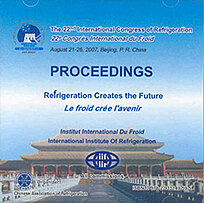
IIR document
Static analysis of desiccant wheel. 1. Construction of simulation model and investigation of validity of the model.
Author(s) : YAMAGUCHI S., SAITO K., KAWAI S., et al.
Summary
A desiccant air conditioning system is getting attention because it can improve the indoor air quality. In the desiccant wheel, as very complex phenomena occurs in the desiccant wheel, simulations have been carried out to grasp these phenomenon. So far, most of the simulation models have been based on only one air channel. In these models, boundary conditions vary periodically so that these models have to deal with unsteady conditions. But in this paper, a static simulation model of the desiccant wheel is suggested. As the authors' model is static, they can solve steady-state conditions without considering unsteady terms. This model is very useful for the system design. Experiments are carried out to confirm the validity of the model. The authors use the desiccant wheel HY-SG produced by NICHIAS Corporation. This wheel adopts the silica gel as a desiccant. Experiments are conducted using the apparatus that can make the inlet conditions of the process and regeneration air constant. Simulation results are compared with experimental ones. As a result, simulation results agree with experimental ones well. Therefore, the validity of the model is confirmed (see also this Bulletin, reference 2008-0787).
Available documents
Format PDF
Pages: ICR07-E1-1008
Available
Public price
20 €
Member price*
Free
* Best rate depending on membership category (see the detailed benefits of individual and corporate memberships).
Details
- Original title: Static analysis of desiccant wheel. 1. Construction of simulation model and investigation of validity of the model.
- Record ID : 2008-0786
- Languages: English
- Source: ICR 2007. Refrigeration Creates the Future. Proceedings of the 22nd IIR International Congress of Refrigeration.
- Publication date: 2007/08/21
Links
See other articles from the proceedings (839)
See the conference proceedings
Indexing
- Themes: Humidification/dehumidification equipment
- Keywords: Comparison; Desiccant wheel; Simulation; Modelling; Expérimentation; Air conditioning
-
Performance analysis of a multi-partition desic...
- Author(s) : SHIBAO Y., YAMAGUCHI S., SAITO K., et al.
- Date : 2007/08/21
- Languages : English
- Source: ICR 2007. Refrigeration Creates the Future. Proceedings of the 22nd IIR International Congress of Refrigeration.
- Formats : PDF
View record
-
Static analysis of desiccant wheel. 2. Performa...
- Author(s) : YAMAGUCHI S., SAITO K., KAWAI S., et al.
- Date : 2007/08/21
- Languages : English
- Source: ICR 2007. Refrigeration Creates the Future. Proceedings of the 22nd IIR International Congress of Refrigeration.
- Formats : PDF
View record
-
Study on the efficient drive of a desiccant air...
- Author(s) : JEONG J. S., HORIUCHI Y., HYUN S. G., et al.
- Date : 2002/12/04
- Languages : English
- Source: Green breeze from Asia: frontiers of refrigerants, heat transfer and system.. ACRA-2002. Proceedings of the Asian conference on refrigeration and air conditioning.
View record
-
Performance analysis of multi-partition desicca...
- Author(s) : JEONG J., YAMAGUCHI S., SAITO K., et al.
- Date : 2008/09/07
- Languages : English
- Source: 8th IIR-Gustav Lorentzen Conference on Natural Working Fluids (GL2008)
- Formats : PDF
View record
-
Effect of design and operating conditions on pe...
- Author(s) : TSUTSUI K., YAMAGUCHI S., SAITO K., et al.
- Date : 2008/09/18
- Languages : English
- Source: HVAC Energy Efficiency Best Practice Conference
- Formats : PDF
View record
